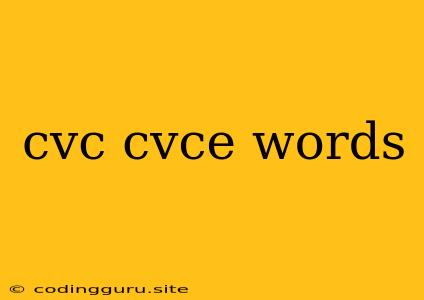Diving into CVC and CVCE Words: A Guide for Young Learners
Learning to read and write is a fundamental skill, and understanding the building blocks of words is a key part of that journey. For young learners, CVC and CVCE words are a great starting point. These simple words provide a solid foundation for developing reading fluency and spelling skills.
But what exactly are CVC and CVCE words? And why are they so important? Let's break it down!
What are CVC Words?
CVC stands for Consonant-Vowel-Consonant. These words contain three letters, with a consonant at the beginning, a vowel in the middle, and a consonant at the end. Think of words like:
- cat
- dog
- sun
- big
- hop
These words are simple to pronounce and visually recognize, making them ideal for beginners. They are often the first words children learn to read and write.
What are CVCE Words?
CVCE stands for Consonant-Vowel-Consonant-E. These words contain four letters and follow a similar structure as CVC words, but with an added silent 'e' at the end. This silent 'e' changes the sound of the vowel in the middle. Let's look at some examples:
- cape
- cube
- kite
- home
- bike
Notice how the vowel sound in these words is longer than the vowel sound in CVC words like 'cap', 'cub', 'kit', 'hom', and 'bik'. The silent 'e' acts like a magic spell, making the vowel say its name!
Why are CVC and CVCE Words Important?
- Foundation for Reading: Mastering CVC and CVCE words forms the foundation for decoding more complex words.
- Spelling Skills: By understanding the sound-letter correspondences in these simple words, children develop a strong base for spelling.
- Building Confidence: Successfully reading and writing simple words boosts a child's confidence and motivation to learn more complex words.
Tips for Teaching CVC and CVCE Words
- Start Simple: Begin with CVC words and gradually introduce CVCE words.
- Visual Aids: Use flashcards, picture books, and manipulatives to illustrate the words.
- Phonics Games: Engage in interactive games like word searches, matching, and bingo.
- Real-World Connections: Incorporate CVC and CVCE words into everyday conversations and activities.
- Practice, Practice, Practice: Consistent practice helps solidify the learning process.
Fun Activities for CVC and CVCE Words
- Build a Word Wall: Create a visual display of CVC and CVCE words in your classroom or home.
- Word Sorting: Sort words into categories based on their beginning sound, ending sound, or vowel sound.
- Create a Story: Write a story using only CVC and CVCE words.
- Rhyming Games: Play rhyming games using lists of CVC and CVCE words.
- Word Puzzles: Create crossword puzzles, word searches, or jigsaws that include CVC and CVCE words.
Examples of CVC and CVCE Words in Context
CVC:
- The cat sat on the mat.
- The dog barked at the sun.
- Big red bus.
CVCE:
- The kite flew high in the sky.
- The home was made of brick.
- He rode his bike to the store.
Conclusion
Learning CVC and CVCE words is a crucial step in a child's literacy journey. By understanding these basic word structures, young learners develop a strong foundation for reading and writing. Through engaging activities and consistent practice, children can master these simple words and pave the way for success in their literacy development.
